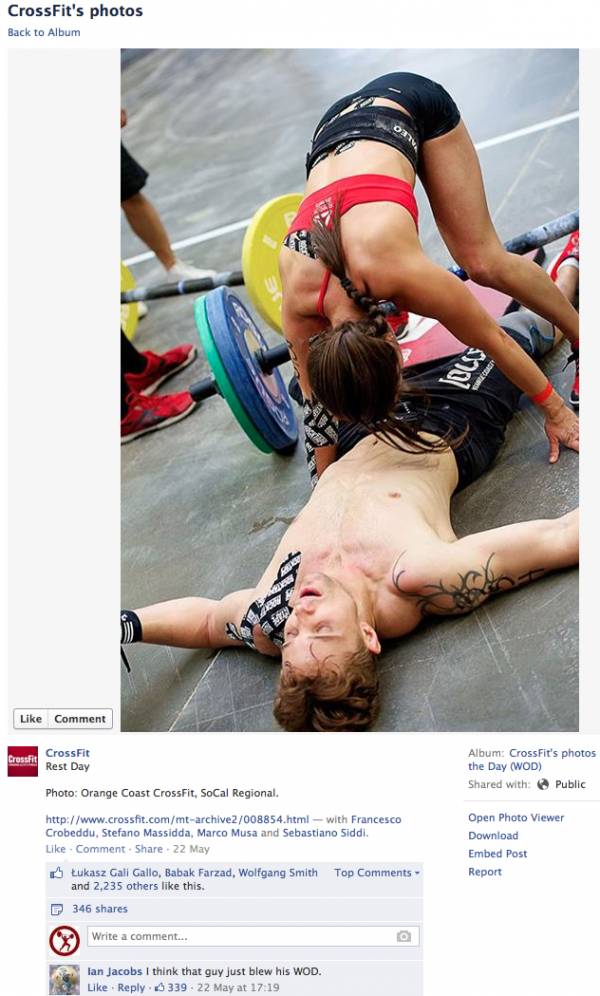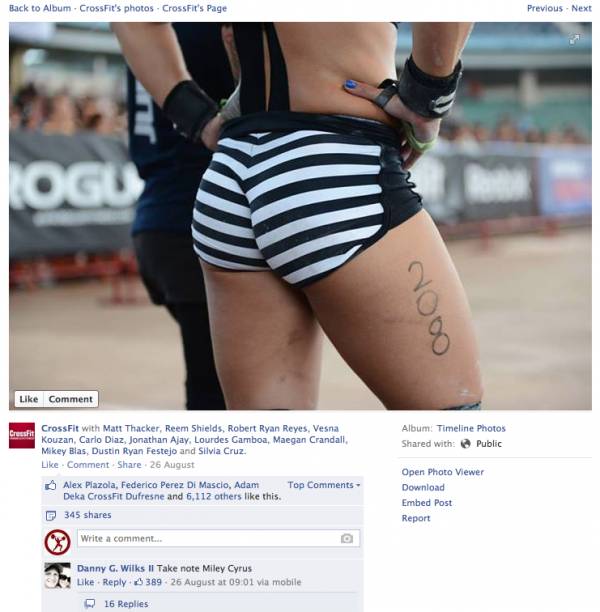“Rage-baiting is commonplace and infuriatingly successful, so the most prevalent language of the Internet is at its best cynicism and its worst outright meanness.”
– Emily Layden, Motherlode
Nothing in marketing happens by accident. Nothing.
Which is why this photo is no accident.
“Rage-baiting is commonplace and infuriatingly successful, so the most prevalent language of the Internet is at its best cynicism and its worst outright meanness.”
– Emily Layden, Motherlode
Nothing in marketing happens by accident. Nothing.
Which is why this photo is no accident.
That’s Talayna Fortunato climbing a rope at the 2013 CrossFit Games, posted on both Instagram and the CrossFit Facebook page by CrossFit’s media team. Now, you may notice that she is highly ripped, and has fantastic arms. But that’s not why the picture was posted.
The picture was posted because her legs are splayed directly into the lens of the camera.
Comments on this picture on Facebook range from “Rope porn!” and “That’s one strong cameltoe she’s got” and “Am I the only one that’s wants to be the rope?” to “Amazing!” and “Those Abs. Incredible.” There is also everything in-between, including people who are calling out CrossFit for posting such an image, and those people bullying those who are speaking up against the image.
Why would CrossFit Media post a picture of one of their beloved athletes, the 2012 second place finisher and, by all accounts, a really nice person, on their social media sites in such a compromised, clearly provocative position?
The CrossFit Media team knows a good picture when they see it. They know what translates into likes, shares, and page views. They know that controversy trumps the commonplace, that stirring up a hornet’s nest will land them hundreds more followers, and that their audience grows with every new embarrassing picture posted. They are a savvy bunch.
What they don’t know is the emotional response at the other end of the photo. While CrossFit Media can hide behind photo releases and athlete waivers, what is the net effect of the humiliation being thrust upon an unsuspecting athlete when they post what is clearly an unflattering photo?
Take this picture for example.

At the SoCal Regionals this image was snapped at the conclusion of the Sunday morning team workout. Marly Campos, from OCCF Team Black, tripped over the finish mat and stumbled over her teammate. As she was getting up, the picture was taken.
CrossFit posted this on their main page. To make matters worse, they had the audacity to ask readers to caption the photo. That’s right – CrossFit, Inc. had a “caption contest” with this very photo.
The response was exactly what you might expect – plenty of “post workout protein” comments, and some much worse. But also interesting was the battle between those who protested and those who saw fit to bully the protesters. A common theme arises whenever a photo like this is posted and it goes something like this:
Protester: “Come On, CrossFit, this is beneath you. Posting a purposely titillating picture like this makes CrossFit and all of us look bad.”
Bully: “Why don’t all you whiners shut your mouths and go back to the globo gym where you belong? This is funny. Get a sense of humor why don’t you?”
Here’s the problem about “getting a sense of humor” about a picture like this. If the subject of the joke is not in on the joke, you can transition quickly from having a lighthearted snicker to laughing at someone else’s expense. And it’s never safe to assume your subject will find the joke funny.
In fact, you can’t predict the reaction of the subject of the photo at all. It’s different when that person submits their own photo to HQ for consideration on the CrossFit main page, with full complicity and knowledge.
If you submit an image of yourself doing a one-legged squat on top of an Atlas stone with a bar overhead – a staged photo with a willing participant, and an intentional submission – well then, bring on the “You just went full retard” comments. You got what you wanted.
But if, during some competition you are giving your heart and soul and in the process, are caught in some awkward moment with your legs splayed, your nipples showing through your sports bra, or your cheeks hanging out, then the organizers of the event have a choice to make: use your image for a cheap laugh and web traffic, or leave it alone?
It’s a decision many sports editorial journalists make all the time. I am quite certain that EPSN’s photography staff has a terabyte of photos of embarrassing crotch shots of Serena Wiliams as she dives for a forehand shot just out of reach.
But discretion being the better part of valor, they choose to use the more professional and equally as compelling shots to lead with on their website and magazine cover – letting quality of content bring them sales, not salacious nipple slips.
Moreover, it is impossible for those at CrossFit Media to know what’s going on in the head of the young lady at the other end of that photo. What they can’t predict is whether the female (or male) athlete in the shot is laughing along with them or whether they are in self-esteem damage control. And before you suggest that this is me crafting a benign molehill into the Andes, consider this – it takes little to crush a person’s self esteem.
And besides the possible emotional damage that lurks as a major variable in the posting of these pictures it’s flat out disrespectful. This girl is not just as ass. She has a brain, a personality, parents who love her, and a story. That picture was posted twice – once on the Games Facebook site and again on the CrossFit Facebook page. Reason? You tell me.

CrossFit is supposed to be a method by which bodies are built, confidence is built, and community is built. It saddens me to think that there may be some fourteen-year-old badass young lady on the cusp of breaking through who chooses another sport because she sees how women are treated by the media and by extension, the bullies and jerks who post under the images. “I want to do CrossFit, Mom, but every picture I see is a girl’s butt.”
So here’s my takeaway
- CrossFit Media – stop it. You guys should be better than this. You can’t feign ignorance and claim you had no idea that what you were posting was potentially embarrassing, inflammatory, or disrespectful. You know what you’re doing. It’s certainly good marketing, but it shits on the very athletes who make your sport grow more popular every day. Grow up. You no longer need your edgy, guerilla marketing. CrossFit is a snowball rolling down a hill now. Take the high road and I am willing to bet you won’t lose one single dollar of revenue.
- Athletes – choose to speak up. If and when CrossFit decides to use a less than flattering image of you online, if you don’t like it, make a fuss about it. You know whom to contact. As soon as you see one “Man, what I wouldn’t give to…” comment, jump on it and take action. Demand the respect you deserve for working so hard to get where you are. You are more than just an ass-cheek and the target of drooling commentary from Facebook annonymi.
- To those who would comment with your protein-intake sniggers, your “Wish I was that rope” or “Dat ass” comments – use your brains. Consider that is a person, and wonder what that person’s mother might think if she logged on and read hundreds of degrading comments directed at her daughter. Put yourself in the position of parent. Still want to make the comment?
- Finally, for all of you Internet bullies who think speaking out is whining – shame on you for hiding behind Facebook and the Internet as your security blanket of tough-guy-ism. Bullies will always exist, and I will always endeavor to call them out. See you on Facebook. Best of luck sleeping.
Talayna Fortunato, Marly Campos, and Stacey Tovar – they deserve our respect. And not because they are phenomenal CrossFit athletes. Because they are human beings. It starts and ends there.
Graphics are screenshots of Facebook; original photos are property of CrossFit, Inc.






